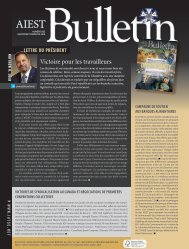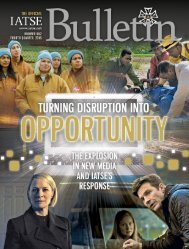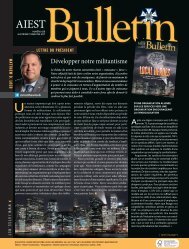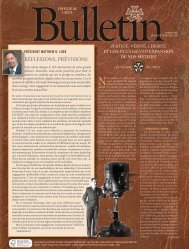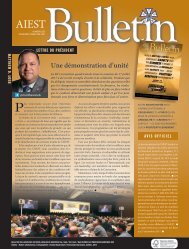The Official Bulletin - Quarter 2, 2019
- No tags were found...
Create successful ePaper yourself
Turn your PDF publications into a flip-book with our unique Google optimized e-Paper software.
“<strong>The</strong> work our members have<br />
done with video walls and<br />
green screen technology lends<br />
itself to what is needed”<br />
Michael F. Miller, Jr., International Vice President<br />
and Department Director for Motion Picture and TV Production<br />
speed on all the technologies they must operate. For example,<br />
we’ve been training members in using Watchout multi-display<br />
software And our members are developing new software tools<br />
to integrate with game engine programs for video playback<br />
that gives the Producers and DPs the level of production flexibility<br />
they’ve never had before.”<br />
Miller emphasized that volumetric capture is far from the<br />
only advance in technology and automation in the motion picture<br />
field. Digitization has transformed every area of film and<br />
video production, from camera to sound, from computer graphics<br />
and animation to editing, from set design to the projection<br />
of films in theaters. “<strong>The</strong> shift to ultra-high definition video,<br />
reductions in camera size coupled with greater flexibility, and<br />
the need to process far more video and audio data have had<br />
a huge impact,” he said. “<strong>The</strong>re have also been tremendous<br />
gains in lighting technology, particularly involving LED, and in<br />
power requirements. Our members are operating lighting consoles<br />
that hadn’t even been contemplated seven to ten years<br />
ago and using tablets to control them.”<br />
Chris O’Donnell, Business Manager of Local 481, noted<br />
that the newest lighting technologies have now come to film<br />
and television production after years of use in the theatrical<br />
and live event world. “It’s finding increasing application not<br />
only on production stages with rigged lighting, but on practical<br />
locations as well,” he said. “This technology requires an experienced<br />
Lighting Programmer on set and increasingly a Set<br />
Lighting Department that knows and understands digital and<br />
automated lighting, their capabilities, and overall use. <strong>The</strong>se<br />
advancements add a great deal of flexibility in color mixing,<br />
dimming, and lighting f/x and this will affect how other departments<br />
interface with this emerging technology.<br />
“One Local 481 Lighting Programmer told me that if LED<br />
fixtures continue to be used in the film and TV markets at such<br />
a great rate, gel manufactures could be out of business soon<br />
or need to diversify,” O’Donnell said. “On a stage, the Programmer<br />
works with the Art Department’s drawings and the Gaffer’s<br />
notes, and using Vectorworks or Auto cad, creates an<br />
accurate scale light plot which will be used to rig and prep the<br />
lights on stage. Depending on the size and complexity of the<br />
design, this process can require weeks of prep.<br />
“On set, once the light is placed, powered, and focused,<br />
the lamp operator is now free to move on to the next task leaving<br />
the fine tuning of the light to the Gaffer and the Programmer,”<br />
O’Donnell added. “<strong>The</strong> process of troubleshooting a light<br />
now goes way beyond, ‘Is there power and does the lamp<br />
work?’ Additionally, lights on set are increasingly controlled<br />
wirelessly, which has made RF management a growing priority<br />
on a film and TV production location as well (a known requirement<br />
on large music and sports events for years). One Lighting<br />
Programmer suggested that soon productions may need a<br />
dedicated person managing frequencies for the lighting, camera,<br />
sound, and video assist and playback departments.”<br />
“When it comes to motion picture and television, we don’t<br />
lose jurisdiction due to technological changes,” Miller said.<br />
“What’s key is emphasizing the continued importance of training,<br />
so our members can expand their skills and we continue<br />
to be the best workforce — indeed, the only world-class workforce<br />
— in the entertainment industry.”<br />
SECOND QUARTER <strong>2019</strong> 23






